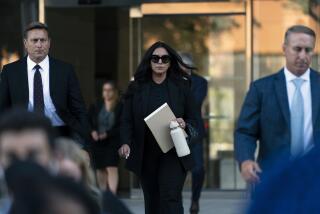Photos of Lindh Ordered Destroyed
- Share via
ALEXANDRIA, Va. — The federal government acknowledged Friday that an untold number of U.S. military service members took “souvenir” photographs of John Walker Lindh during the first days of his captivity, but it added that the images were destroyed because they were taken without military approval.
Randy L. Bellows, an assistant U.S. attorney, made the acknowledgment during a hearing in federal court here in which Lindh’s defense attorneys had hoped to obtain copies of the photographs and videos. The defense sought to use them as potential evidence that Lindh was intimidated and coerced into making allegedly incriminating statements to U.S. authorities after he was captured late last year fighting for the Taliban in Afghanistan.
Bellows said the unauthorized photographs and videos were taken when Lindh, a 21-year-old from Northern California, was brought aboard the Peleliu in December. At that time, Lindh was being roundly derided in the United States as the so-called American Talib soldier who had betrayed his country and gone to Afghanistan to work on behalf of the Al Qaeda terrorist network.
Aboard the ship, he was kept in irons, blindfolded and strapped to a gurney--all of which made him stand out as a prize captive for the U.S. in the early phases of the war on terror.
Indeed, George C. Harris, one of his defense attorneys, said government prosecutors have been told by the chief master of arms of the Peleliu that Lindh was in horrible shape when he arrived on board.
“He immediately noticed Mr. Lindh couldn’t walk without aid, that he was taken aboard in a wheelchair, and he passed out,” Harris said. “He was dehydrated and he was given an IV.”
Lindh was held on the ship from Dec. 14-31.
It was there that a Navy doctor removed a bullet that had struck Lindh while he was fighting with the Taliban against the Northern Alliance in Afghanistan.
During this time on the ship, and earlier too, Lindh made a number of statements to U.S. officials, allegedly about his activities as a Taliban soldier and his alleged connection to Al Qaeda.
Those statements are at the heart of the government’s case. But the defense is arguing that they should be excluded from his trial in August because he was coerced, in poor shape and was intimidated by the U.S. military.
Bellows said about 300 authorized photographs and videos were taken of Lindh aboard the ship, but that the images made by individual service members were not approved by the ship’s executive officer.
Bellows said all of the photos and videos were destroyed, along with as many as a dozen cameras.
But he denied that the individual service members were mocking Lindh as a trophy captive.
“There was nothing going on that was nefarious,” Bellows said. “These were just not authorized, and that’s why they were destroyed.”
But Harris intimated that the photos and videos were all part of a harassment campaign to force Lindh into talking. “It shows mistreatment and intimidation,” the defense lawyer said.
U.S. District Judge T.S. Ellis III pressed Harris on whether he had any evidence that Lindh was purposely intimidated. Harris responded that the defense simply wanted to learn exactly how their client was treated.
“We want to know if similar things happened,” he said.
On another matter, both sides agreed that 30 service members who took statements from Lindh or made written observations about his condition in captivity can be interviewed by defense attorneys.
More to Read
Sign up for Essential California
The most important California stories and recommendations in your inbox every morning.
You may occasionally receive promotional content from the Los Angeles Times.














